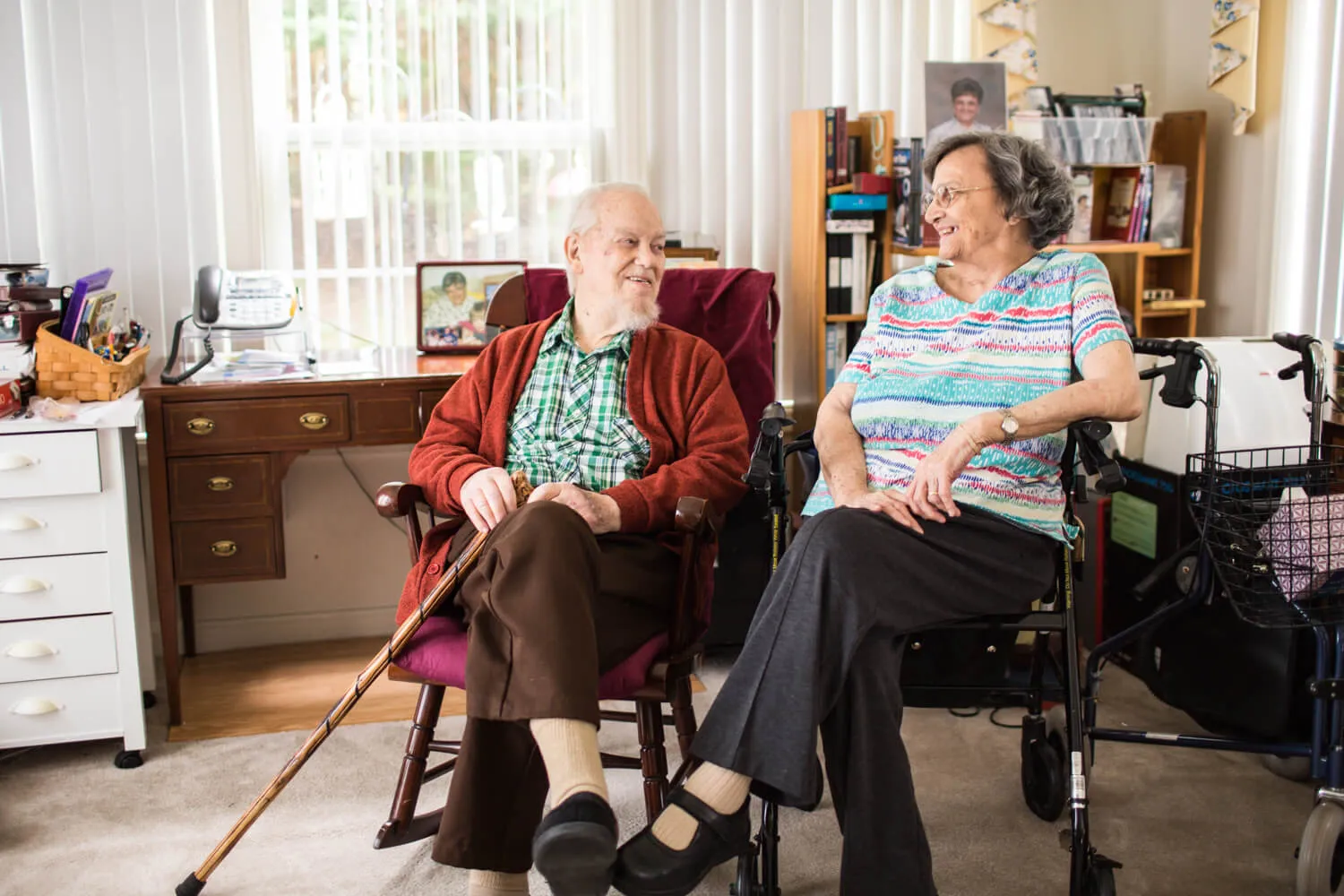As a caregiver, you play a vital role in ensuring the well-being and quality of life of your loved one. It takes a special kind of love and dedication to care for someone with Parkinson's disease. However, caring for someone with Parkinson's disease can become complicated, especially as the disease progresses through its various stages.According to the Parkinson's Foundation, research suggests that approximately one million people in the United States are living with Parkinson's disease, with an estimated 60,000 new cases diagnosed each year. As the population ages, these numbers are expected to increase. But there is hope. With the right home care plan and strategies, you can provide the support and care your loved one needs to manage the symptoms of Parkinson's disease at every stage.This article will provide valuable insights and strategies for caring for someone with Parkinson's disease at home.

What Is Parkinson's Disease?
Parkinson's disease is a movement disorder caused by the lack of dopamine in the brain. It can occur when the brain's dopamine-producing cells begin to die, leading to a shortage of dopamine. Dopamine is a chemical messenger that plays a crucial role in controlling movement, and its depletion causes motor symptoms of Parkinson's disease, like tremors, stiffness, and slow movements. As the disease progresses, symptoms get worse and pd patients may experience balance problems, muscle atrophy, difficulty chewing, difficulty speaking, and cognitive impairment.While there is no cure for Parkinson's disease, medical treatment and a strict medication regimen may help manage the symptoms and improve a person's quality of life.For more information on the symptoms and what is Parkinson's disease, visit our recent article. (LINK NEEDED)
What Is the Main Goal of Care for Parkinson's Disease Patients?
The main goal of care for people with Parkinson's disease is to help them maintain their independence, maximize their quality of life, and manage the symptoms of the disease so they can live happily, pain-free. With the proper care plan, your loved one can continue to live a fulfilling life while managing their condition.Read on to learn more about the different stages of Parkinson's disease and what you can do as a caregiver to care for your loved one and help them manage their condition as it progresses.
Stages of Parkinson's Disease and Home Care Plans
Parkinson's disease is a chronic illness that can be challenging to navigate as it progresses through various stages. Each stage comes with unique symptoms and care needs. As a caregiver, it is crucial to understand the five stages of Parkinson disease and develop a customized home care plan for your loved one to manage their symptoms and improve their quality of life at home.There are five stages of Parkinson's disease, ranging from mild to severe. Home care plans may vary from stage to stage and can play an essential role in managing the care of your loved one. All home care plans, at any stage, should include a medication regimen, exercise routine, physical therapy, and lifestyle modifications. Read on to learn more about how the stages differ and the strategies to help you manage your loved one's symptoms and improve their quality of life at home.
Parkinson's Disease In Stage One
A Parkinson's disease nursing diagnosis may be the first step. In this stage, mild symptoms may arise and are often barely noticeable but, hopefully, diagnosed for early intervention. Some symptoms could include:
- Slight tremors.
- Changes in posture.
- Balance problems.
- Changes in facial expressions.
While this stage can be much more manageable independently than other stages of the disease, developing a home care plan is still essential to help manage symptoms and slow the progression.
Home Care Plan for Stage One
The first step to managing stage one of Parkinson's symptoms is through regular exercise and increased mobility. It is recommended to maintain mobility in order to reduce the rate of progression regularly. Some ideas could include regular:
- Walking.
- Swimming.
- Cycling.
- Physical therapy.
- Facial muscle exercises.
- Balance exercises.
- Stress management through yoga, relaxation techniques, and breathing exercises.
- Activities that increase muscle strength and increase flexibility.
Exercise can help improve symptoms and reduce the risk of falls. A vital factor to consider in the daily routine is adequate rest, a balanced diet, and hydration. Proper medication management can also help manage the symptoms of Parkinson's disease at this stage.Suppose you're a caregiver or loved one of someone with Parkinson's. In that case, monitoring their condition closely, maintaining a positive attitude, and providing ample emotional support during this stage is important.

Parkinson's Disease In Stage Two
In stage two, your loved one's symptoms may become more noticeable and could start to affect both sides of the body. Individuals in stage two may experience a reduced ability to perform daily tasks like:
- Dressing.
- Bathing.
- Cooking and eating.
- Walking.
- Transferring from standing to sitting, etc.
At this stage, a comprehensive home care plan is more vital than ever.
Home Care Plan for Stage Two
An essential component of stage two of Parkinson's disease is frequent physical and occupational therapy visits. A physical therapist will help your loved one maintain mobility, reduce stiffness, and improve their balance using techniques, exercises, and interventions. You may also consider an occupational therapist to help develop specific strategies for performing daily living activities.Medication management remains an essential aspect of stage two. Create a regular regime for taking proper medications at the correct times as prescribed. Many medications will be dopamine agonists, which help activate dopamine receptors in the brain cells. Therefore, a caregiver at this stage is more coveted to help patients ensure they take medications safely and correctly.Another component of stage two is ensuring the home has the necessary safety precautions to avoid tripping hazards or the potential risk of falls. This may include installing grab bars in the bathroom and using assistive devices such as canes or walkers to help with balance.In stage two, many patients, especially elderly patients, acquire additional support from professional caregivers to help them with daily living. That's where Nurse Next Door comes in. At this point in the disease, our professional caregivers can assist primary caregivers through respite care or personal care services with activities for daily living, including:
- Meal preparation.
- Personal care (like dressing, bathing, walking, transferring).
- Transportation to and from doctors' appointments, physio, or occupational therapy.
- Housekeeping.
- Companionship for emotional support and mental health.
As the primary caregiver of someone you love with Parkinson's disease, maintain open communication with your loved one and healthcare team so you can support them to the best of your ability.

Parkinson's Disease In Stage Three
At this point in the disease, your loved one's symptoms may have become more severe. They may have lost their sense of balance and coordination, increased slow movements, and could have significant difficulty performing daily activities.A patient's ability to perform tasks independently may not be possible at this stage. A professional caregiver could be the saving grace at this stage.
Home Care Plan for Stage Three
With stage three, you will still want to focus on your home care plan outlined in previous stages but amp up on physical and occupational therapy. Concentrating on these two areas will help your loved one maintain and improve their mobility as the disease progresses.
- Physical therapy: stage three becomes even more critical as the individual's mobility becomes increasingly affected. The physical therapist will focus on increasing muscle coordination, gait, and balance, improving strength, and managing pain or discomfort.
- Occupational therapy will shift towards improving independence and safety in daily activities. The therapist may suggest adaptive equipment to help with dressing, grooming, and other daily tasks.
A patient's ability to speak may also be affected in this stage. Therefore, your loved one may opt for speech and language therapy. Caregivers can also modify the patient's environment even more. As mobility decreases, the home environment will need to shift as well. This could mean adding in a stairlift or wheelchair ramp or even modifying the bathroom for better accessibility.During the third stage, PD patients may experience depressive symptoms. As symptoms worsen with every step, emotional support becomes even more critical. It's valuable to continue being patient, compassionate, and reassuring to support your loved one throughout their journey.
Parkinson's Disease In Stage Four
Mobility becomes a significant concern in stage four of the disease process. Walking and other movements may become painful, and assistive devices may be necessary. Tremors can also become much more pronounced and challenging. Individuals should not be left alone as they risk falling and becoming more confused.
Home Care Plan for Stage Four
In this stage, many individuals may be unable to live independently or conduct any activities independently. Nursing interventions may be used to address advanced Parkinson's disease. For example, deep breathing exercises may be utilized to help individuals cope with their breathing problems due to muscle weakness. A breathing exercise promotes maximal lung expansion, making it easier for the individual to breathe.The decision to blend or puree the food may depend on the individual's specific symptoms. In some cases, patients may experience difficulty swallowing in the later stages, increasing their risk of aspiration and pneumonia. If your loved one is having difficulty chewing or swallowing, a speech therapist or dietitian may recommend modifying the texture of the food to make it easier to swallow.Some families may consider moving their loved ones to a long-term care facility or getting around-the-clock care to support them at home. In stage four, full-time caregiving is most likely required and encouraged.

Parkinson's Disease In Stage Five
The last stage of Parkinson's can be the most difficult for family members. It's never easy seeing your loved one in pain, especially when they do not have control over their physical body. Stage five is the final stage of Parkinson's disease, also known as the advanced stage. At this stage, Parkinson's disease has significantly affected the person's ability to function independently, where movement becomes completely impaired.This late stage of Parkinson's is when full-time care is required, and even further medical and nursing interventions are needed.
Home Care Plan for Stage Five
Home care for individuals in stage five requires a comprehensive approach to address complex care needs.
- Mobility and safety: caregivers should ensure that the living environment reflects the needs of the individual and is completely free of hazards.
- Personal care: all aspects of personal care may require support. For instance, transferring becomes quite challenging, especially moving to and from the bed. You might need a team of caregivers to help move a person onto a bed, or you may use specialized equipment to support the transition. A professional caregiver or nurse can support you with daily living activities and work closely with the individual to meet their needs.
- Medication management: at this stage, medication management becomes more complex. Caregivers should work closely with the healthcare team to ensure that prescribed medications are appropriately administered and report any side effects or concerns to doctors.
- Breathing problems: In the late stage, individuals may experience respiratory issues due to muscle atrophy or weakness. This is especially true if they develop pneumonia or other respiratory infections. If this is the case, nurses may encourage deep breathing and need supplemental oxygen to support their breathing.
- Communication: communication can be tough in the last stage of the disease. Caregivers can explore different communication methods, like using an electronic device to facilitate social interaction.
- Nursing Interventions: nurses may need to monitor oxygen saturation levels and continue to monitor other symptoms in the late stage. Comfort is key in the later stages, so nurses may need to provide a treatment regimen focusing on comfort and pain reduction.
- Hospice care: in the advanced stage, hospice or palliative care may be necessary to provide the proper support for the individual and their loved ones.
Remember, caring for someone with Parkinson's disease is a journey that requires patience, love, and understanding. You can make a positive difference in your loved one's life with the right support and resources.Need help and support for your loved one with Parkinson's disease? Contact Nurse Next Door today to learn how we can help you make the most of your care journey. Get started today!


























